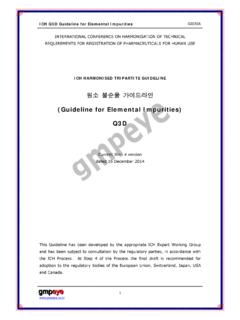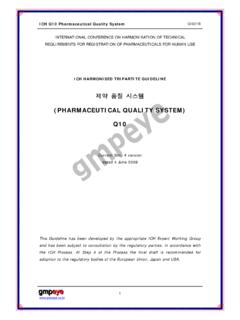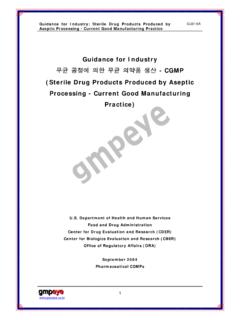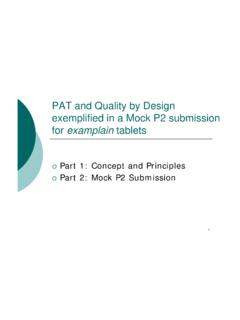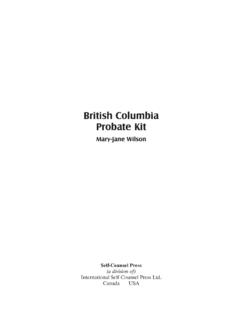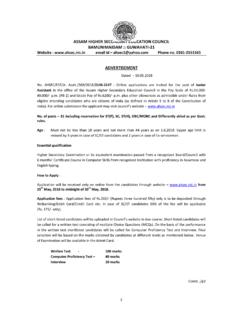Transcription of Mock P2 for 'Examplain' Hydrochloride - gmpeye
1 mock P2 for & quot ; examplain & quot ; Hydrochloride - Draft Discussion Paper- 1 2 3 4 5 6 7 8 9 10 11 12 13 14 15 16 17 18 19 20 21 22 23 24 25 26 27 28 29 30 31 32 33 34 35 36 37 38 39 40 41 42 43 44 45 46 47 48 49 Overall Objective The overall objective of this mock P2 Draft Discussion Paper is to facilitate a scientific and regulatory dialogue between the Industry Association, EFPIA and Regulatory Authorities on the presentation of enhanced product and process understanding in regulatory dossiers, as suggested by ICH Q8 guideline, Pharmaceutical Development (Step 2) and how this could provide .. develop more flexible regulatory approaches (ICH Q8).
2 In addition, the document attempts to illustrate how the principles of Quality Risk Management as outlined in ICH Q9, Quality Risk Management (Step 2) are applied during the development process and how these principles could be presented in a section of the CTD format. The discussion paper serves as a draft of current industry thinking and to promote discussion and learning between companies, and between EFPIA and Regulatory Authority reviewers and inspectors. This document is not intended to be taken as the standard for future applications. Key Aspects This draft discussion paper attempts to illustrate the following key aspects relating to ICH Q8 and Q9 principles Enhanced Process Understanding/Quality by Design - To exemplify how modern in- or at-line analytical technologies can assist with process understanding - To illustrate the type and extent of information that would constitute.
3 Other pharmaceutical development studies that lead to an enhanced knowledge of product (ICH Q8) - To illustrate the use of Design of Experiments (DOE) in process development - To exemplify how multivariate models can be generated and used for prediction Design Space - How it is established through scientific understanding, including use of multivariant models - How it could be represented in regulatory submissions - How it could be linked to process control strategies Quality Risk Management - Approach to risk assessment throughout the development process - Approach to risk management in the design of the control strategy - Presentation of risk management in a regulatory submission Version 3 24 Jan 06 Page 1 of 69 mock Roadmap 50 51 This document is not a complete P2 Pharmaceutical Development section.
4 Some sections of the manufacturing process design are only briefly described, and some sections not described at all, which may give rise to perception of incoherence of the technical arguments in parts. The focus has been on those section which are key to the scope of the proposed discussion. 52 53 54 55 56 57 58 59 60 61 62 63 64 65 66 67 The main purpose is to exemplify some fundamental principles and key concepts using a conventional, wet granulated tablet formulation of a relatively low dose, highly soluble, highly permeable (Biopharmaceutics Classification System Class I) drug substance, which has some potential for degradation.
5 The flow of the discussion is presented in the chart (below) summarising the goals of the development (Target Product Profile) through the development process itself, generation of the proposed design space and associated control strategy, and finally proposed regulatory flexibility. An Industry View of QbDin Dossier: Key Scientific Elements and Flow TargetTargetProductProductProfileProfile ControlControlStrategyStrategyPriorPrior KnowledgeKnowledgeProduct/ Space Definition of Product Intended Useand pre-definition of Qualitytargets (wrt clinical relevance, efficacy and safety)Summary of Scientific Understanding of Product and description of Multi-dimensional Space that Assures Quality(interrelation-ships and boundaries of Clinical Relevance).
6 Definition ofControl Strategybased on Design Space leading to Control of Qualityand Quality Risk Mgmt.(Process Robustness)Overview ofQuality by Design key actions and decisions taken to develop New Scientific Knowledge, DoE, PAT, Risk Assessmentand Risk ControlSummary ofPrior Scientific Knowledge(drug substance, excipients; similar formulations and processes). Initial Risk AssessmentRegulatoryRegulatoryFlexibilit yFlexibilityProposal of Regulatory Flexibility based on Product and Process Scientific Knowledgeand Quality Risk Mgmt.(Materials, Site, Scale etc) 68 69 70 71 72 73 74 75 76 77 78 Moisture content after fluidised bed drying has been identified as a critical attribute, and fluidised bed drying is the critical manufacturing step.
7 Studies to produce design space for wet granulation and fluidised bed drying are described in detail. Version 3 24 Jan 06 Page 2 of 69 The description of other unit operations and the impact of all unit operations on some quality attributes have not been described. 79 80 81 82 83 84 85 86 87 88 89 90 91 92 93 94 95 Additionally and deliberately not all data and risk management steps are presented. These data and records of risk management process would be available at a site for inspection if so desired. The mock is complemented by a mock excerpt outlining the process control strategy proposed for routine manufacture.
8 It is designed based on the process understanding and risk assessment data generated during the development process. Section numbering as given in ICH M4Q, The Common Technical Document for the Registration of Pharmaceuticals for Human Use: Quality is followed as far as possible but perhaps not completely accurately. Science and Risk Based Regulatory Approach - Discussion Points 96 97 98 99 100 101 102 103 104 105 106 107 108 109 110 111 112 ICH Q8 (step 2) outlines that demonstration of a high level of formulation and process understanding can provide for maximum regulatory flexibility in the areas of: - risk-based regulatory decisions (reviews and inspections) - manufacturing process improvements within the design space described in the dossier without further regulatory review - real time quality control, leading to a reduction of end-product release testing In this context, the EFPIA PAT Topic Group is seeking feedback and discussion on the following proposals for regulatory flexibility based on the design space, knowledge and understanding exemplified for the granulation and fluid bed drying operations in the examplain mock : and summarized as follows.
9 Version 3 24 Jan 06 Page 3 of 69 112 113 Area for Regulatory Flexibility Position Statement Rationale 1 Continuous Improvement It is proposed to make manufacturing changes within design space Full understanding of process and use of ICH Q8. 2 Real Time Release (RTR) It is proposed that no conventional end product tests be performed routinelyRTR is justified based on an extended process control and monitoring scheme which includes traditional and advanced controls and has been designed based on the process understanding and application of risk assessment. 3 Process Validation It is proposed that the conventional 3-batch validation is replaced by continuous process verification Assurance is given that each process step (exemplified for granulation and drying) is routinely and reproducibly producing suitable material for the next processing step.
10 4 Changes to Scale and Site It is proposed that changes to scale and site be made without Authority approval, provided the process continues to operate within the design space Process understanding and risk assessment have resulted in the establishment of a design space for fluid bed drying that is transferable to and reproduced for different processing equipment, representing different processing scales, potentially on different sites, and which is linked to the routine control strategy. Version 3 24 Jan 06 Page 4 of 69 5 Confirmatory Stability Studies It is proposed not to conduct confirmatory stability studies.

